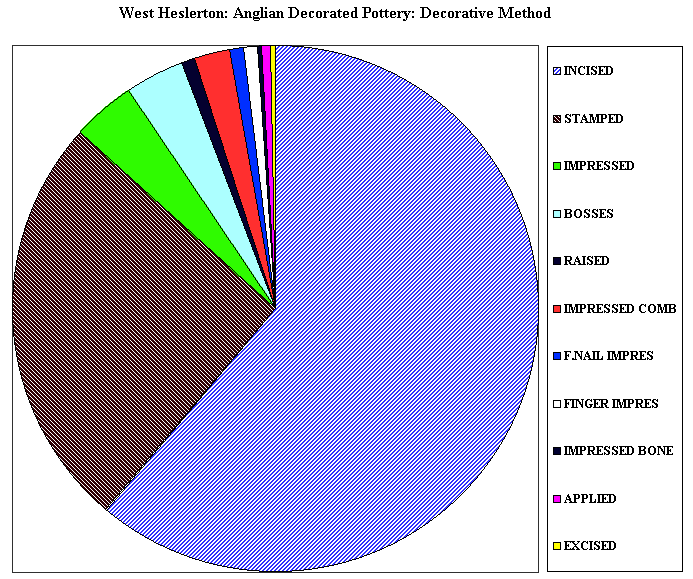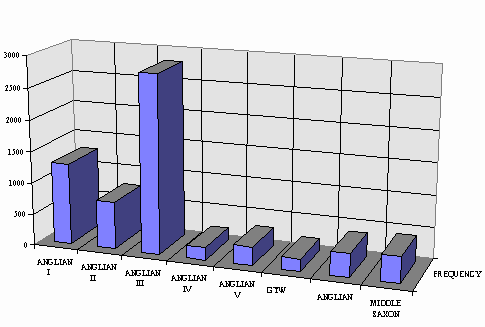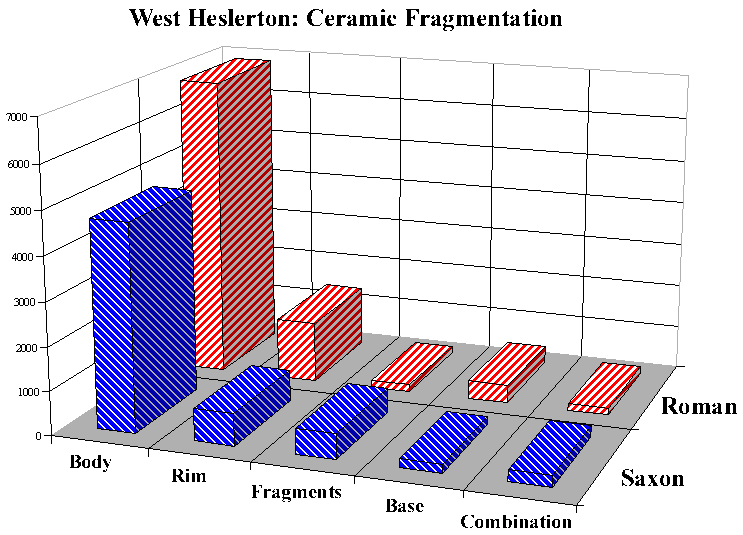
Fig. 3.25 Anglo-Saxon ceramics decorative method
The Early Anglo-Saxon or Anglian ceramic assemblage from West Heslerton is the largest recovered from any site in the North of England, and is well provenanced and well recorded. The Anglo-Saxon ceramics are generally poorly fired hand-made vessels which have few diagnostic features when seen in isolation; the poor quality of many of the fabrics is reflected in the chart on ceramics by period in which a large number of sherds, many being merely fragments, have been assigned no date or fabric class. About 7,500 Anglo-Saxon sherds have been recovered, of which less than 5% were decorated. The total number of Anglian sherds is probably nearer to 10,000 than the 7,500 sherds assigned an Anglian date during field recording, since the ceramic typology was established during the life of the excavation and a large quantity of material was not assigned a date during the primary recording process. Few clear imports were identified during the preliminary recording but once detailed analysis is undertaken it is anticipated that a small imported component will be identified. One example, comprising five glazed sherds from a Grubenhaüs, is clearly late, and although the source has yet to be identified it is thought to be continental. Petrological analysis of a sample of the material by Alan Vince has identified one group with characteristics indicating a source in the Midlands, and more detailed petrological examination of the material and locally available raw materials offers potential for the analysis of local trade or exchange patterns. The presence of further contemporary material from three more sites locally offers an opportunity for an examination of production and exchange within the immediate hinterland of the West Heslerton site.

Fig. 3.25 Anglo-Saxon ceramics decorative method
The raw material, a fine sandy clay, is of local origin. The simplest vessels were made by pressing a hole in the centre of a ball of clay and by pressing and moulding the walls of the vessel into the desired shape; very thin-walled vessels can be made in this way. A second method was to build the pot up from coiled 'sausages' of clay. The pots would have been fired in a simple bonfire kiln, resulting in the vast majority of the sherds having a dark grey to black surface colour; a few have areas of brown, pink or red due to scorching.
The fabric types encountered include six main groups, with Group III then subdivided to form three sub-groups. The clay matrix of each group is fine to medium sandy. The identification of the basic groups which were defined in the field has been largely confirmed by petrological analysis. The actual figures for frequency by fabric will, however, change once detailed analysis takes place, particularly with reference to the northern third of the site, where the types were first identified. Some 5-10% of the material from Site 2 will need to be reclassified in the light of the more precisely identified types recovered from the later seasons. These fabric groupings are seen not only at West Heslerton, but also at the other Early Anglo-Saxon sites locally, particularly at Wykeham and Seamer.

Fig. 3.26 Early Anglo-Saxon ceramic fabrics
from sites in the Vale of Pickering
| Group I: | Calcite-gritted ware, the calcite grits frequently having dissolved out to leave angular voids in the fabric. |
| Group II: | Calcite and mica/biotite inclusions. This fabric is very fragile, tending to laminate. |
| Group IIIa: | Fine sand. |
| Group IIIb: | Medium sand |
| Group IIIc: | Coarse rounded sand |
| Group IV: | Oolitic limestone, frequently dissolved out to leave spheroidal voids in the matrix. |
| Group V: | Calcite and medium sand |
| Group VI: | Straw or dung-tempered; a very light fabric due to its high organic content. (GTW) |

Fig. 3.27 Anglo-Saxon ceramics by classification
(Sites 2 and 11)
A comparative analysis of the material from the three main sites in the Vale of Pickering, West Heslerton, Seamer and Wykeham, has produced unexpected results which deserve clarification as part of the analytical programme. Wykeham, which has much in common with West Heslerton in terms of site location and morphology, has a fabric sequence that is quite different. Seamer, on the other hand, is remarkably similar, although this site can be classed as part of the Fen-Edge ladder settlement with a relatively small Anglian component within the Roman settlement zone. The difference particularly between the West Heslerton and Wykeham material raises important questions regarding the value of fabric as a dating indicator. Unfortunately the records from Seamer and Wykeham are too poor to permit detailed analysis of assemblage make up beyond that of a few features. The lack of good spot-dating material means that the principal potential dating system will be assemblage analysis. It remains to be seen, however, to what extent this will generate a site-specific or regional dating basis. Preliminary indications are that there are significant differences in assemblage make up in the Grubenhäuser, but that this is difficult to quantify until detailed analysis and fabric verification have been undertaken.
The presence of material from both open surfaces and sealed features and the variety of collection methods applied means that the assemblage offers good potential for the study of fragmentation. The difficulty of identifying sites of this class can in part be attributed to the poor quality and survival of the ceramics coupled with the low frequency of decorated types. A simple comparison between the fragmentation of the Roman to Saxon material as a whole reflects the relatively poor survival of Early Anglo-Saxon material in contrast to the well-fired Roman ceramics. Although this material is generally poorly made, the relatively well-preserved assemblages from the Grubenhäuser offer potential for limited re-fitting and the calculation of vessel equivalents, aspects which will have an important part to play in the interpretation of site formation and deformation processes and depositional and ceramic decay processes and disposal patterns. The potential for intra-context as well as inter-context analysis is made easier in particular by the great familiarity with the material and continuity of the project team and particularly the artefact researcher, Christine Haughton, who created the primary record and originally identified the fabric type series (see also 4.10 Anglian Pottery Petrological Assessment and 4.14 Anglo-Saxon Ceramics).

Fig. 3.28 Ceramic fragmentation
© Internet Archaeology
URL: http://intarch.ac.uk/journal/issue5/westhes/3-7-4.htm
Last updated: Tue Dec 15 1998